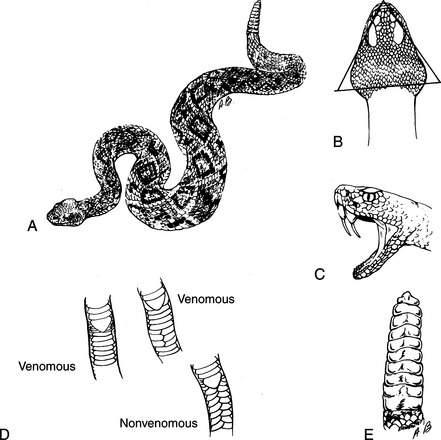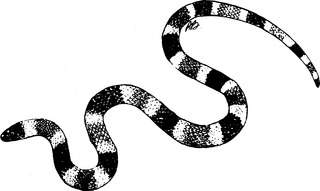SNAKEBITE
POISONOUS SNAKES
Northeast. Cottonmouth, copperhead, timber rattlesnake.
Southeast. Cottonmouth, copperhead, eastern diamondback rattlesnake, pygmy rattlesnake, eastern coral snake.
Central. Cottonmouth, copperhead, massasauga rattlesnake, timber rattlesnake, prairie rattlesnake.
Southwest. Cottonmouth, copperhead, pygmy rattlesnake, massasauga rattlesnake, northern black-tailed rattlesnake, prairie rattlesnake, sidewinder, Mojave rattlesnake, western diamondback rattlesnake, red diamondback rattlesnake, Texas coral snake, Sonoran coral snake.
Pacific Coast. Northern Pacific rattlesnake, southern Pacific rattlesnake, Great Basin rattlesnake, western diamondback rattlesnake, red diamondback rattlesnake, sidewinder, Mojave rattlesnake.
Pit vipers are typified by rattlesnakes, which have a characteristic triangular head, vertical elliptical pupils (“cat’s eyes”), two elongated and hinged fangs in the front part of the jaw, heat-sensing (infrared-sensing) facial pits on the sides of the head midway between and below the level of the eyes and the nostrils, a single row of scales on the underbelly leading to the tail (not seen in nonpoisonous snakes), and rattles on the tail (Figure 179). The snake’s age is not determined by the number of rattles, since molting may occur up to four times a year. Because fangs are replaced every 6 to 10 weeks in the adult rattlesnake, bites may demonstrate from one to four large puncture marks. An adult pit viper can strike at a speed of 8 ft (2.4 m) per second. The rattlesnake may strike without a preliminary warning rattle.
Coral snakes are characterized by their color pattern, with red, black, and yellow or white bands encircling the body (Figure 180). A general rule is “red on yellow—kill a fellow (venomous); red on black—venom lack (nonvenomous).” The fangs are very short and fixed; the snakes have round pupils, and they bite with a chewing, rather than striking, action.
Signs of Envenomation
The most common signs of envenomation are as follows:
Pit Vipers
1. One or more fang marks. Most snakebites (venomous and nonvenomous) will demonstrate rows of markings from the teeth. In the case of venomous snakes, there will be one to four larger distinct markings from the elongated fangs that inoculate the victim with venom (Figure 181). Venomous snakebite wounds tend to bleed more freely than bites from animals and insects.
2. Burning pain at the site of the bite. This may not be present with the bite of the Mojave rattlesnake.
3. Swelling at the site of the bite. This usually begins within 5 to 10 minutes of envenomation and may become quite severe. This may not be present with the bite of the Mojave rattlesnake.
4. Numbness and tingling of the lips, face, fingers, toes, and scalp 30 to 60 minutes after the bite. This can also be present if the victim hyperventilates with fear and excitement (see page 300). If a victim of a snakebite has immediate symptoms, these are likely to be due to hyperventilation.
5. Twitching of the mouth, face, neck, eye, and bitten extremity muscles 30 to 90 minutes after the bite.
6. Rubbery or metallic taste in the mouth 30 to 90 minutes after the bite.
7. Sweating, weakness, nausea, vomiting, and fainting 1 to 2 hours after the bite. Additional symptoms include chest tightness, rapid breathing rate (20 to 25 breaths per minute), rapid heart rate (125 to 175 beats per minute), palpitations, headache, chills, and confusion.
8. Bruising at the site of the bite. This usually begins within 2 to 3 hours. Large blood blisters may develop within 6 to 10 hours.
9. Difficulty breathing, increased bleeding (bruising, bloody urine, bloody bowel movements, vomiting blood), and collapse 6 to 12 hours after the bite.
Stay updated, free articles. Join our Telegram channel

Full access? Get Clinical Tree







